7 Lies the Indoor Tanning Industry Continues to Tell
04 April, 2015
In 2013 Nevada was successful in becoming the 4th state to pass tanning legislation that prohibits minors under 18 from using indoor tanning devices. While this was a win for our state and set us in the lead for the nation in recognizing the dangers of indoor tanning for youth, more than 100 tanning salon locations are still in business within the state. Despite numerous studies and rulings that use of indoor tanning devices are carcinogenic and harmful to one's health, the tanning industry continues to perpetuate misconceptions and myths about indoor tanning to keep their industry alive. Here's a look at seven of the top myths and the science-based truths.
Myth #1: Tanning Beds Are Safe
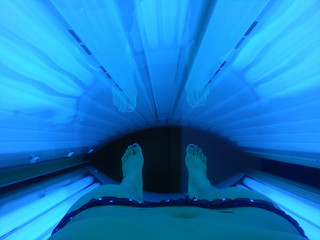 Experts agree that exposure to UV radiation, either from indoor tanning devices or outdoor exposure, increases the risk of developing skin cancer. In 2009 the International Agency for Research on Cancer (IARC) concluded that tanning devices were more dangerous than previously thought and moved them into the highest cancer risk category: “carcinogenic to humans.” Previously, it had categorized the devices as “probably carcinogenic to humans.” Additionally, in 2014 the U.S. Food and Drug Administration (FDA) reclassified sunlamps and tanning bed devices as class II moderate-risk devices and requires warnings on the devices that they are not to be used on persons under 18 years of age. Aside from the cancer risk these devices pose, the Centers for Disease Control and Prevention (CDC) notes other risks include premature aging, such as wrinkles, sagging skin and brown spots, cataracts, genital warts, skin rashes and warts, and flaky discolored patches on the skin. Lovely.
Experts agree that exposure to UV radiation, either from indoor tanning devices or outdoor exposure, increases the risk of developing skin cancer. In 2009 the International Agency for Research on Cancer (IARC) concluded that tanning devices were more dangerous than previously thought and moved them into the highest cancer risk category: “carcinogenic to humans.” Previously, it had categorized the devices as “probably carcinogenic to humans.” Additionally, in 2014 the U.S. Food and Drug Administration (FDA) reclassified sunlamps and tanning bed devices as class II moderate-risk devices and requires warnings on the devices that they are not to be used on persons under 18 years of age. Aside from the cancer risk these devices pose, the Centers for Disease Control and Prevention (CDC) notes other risks include premature aging, such as wrinkles, sagging skin and brown spots, cataracts, genital warts, skin rashes and warts, and flaky discolored patches on the skin. Lovely.
Myth #2: Tanning beds provide a “base tan,” which protects from sunburns before periods of sun exposure, like a tropical vacation.
One salon’s website actually says a base tan is “the color you seek and also your body’s natural protection against sunburn.” They continue, stating that a base tan “enables your skin to have exposure to ultraviolet light without burning.” According to the National Council on Skin Cancer Prevention, tanning beyond one’s natural skin tone is evidence of the skin trying to defend itself against an environmental insult. People who seek a base tan end up with more total sun exposure and therefore more DNA damage.
Myth #3: Tanning beds are a good source of Vitamin D.
 Actually, they’re not. Of the two types of rays emitted by the sun, it’s the UVB rays that help the skin make Vitamin D. UVB rays are also the ones that cause the skin to burn, so in most tanning beds they are either very limited or eliminated in favor of UVA rays. Using tanning beds actually increases the risk for skin cancer and sun damage via UVA rays without any of the Vitamin D benefits!
Actually, they’re not. Of the two types of rays emitted by the sun, it’s the UVB rays that help the skin make Vitamin D. UVB rays are also the ones that cause the skin to burn, so in most tanning beds they are either very limited or eliminated in favor of UVA rays. Using tanning beds actually increases the risk for skin cancer and sun damage via UVA rays without any of the Vitamin D benefits!
Expert: Dr. Deborah Sarnoff, NYU School of Medicine. More Info at SkinCancer.org
Myth #4: Tanning beds and salons are operated by trained professionals that can counsel users on safe tanning methods.
A quick search of the help wanted ads and you’ll find plenty of listings for part-time, entry-level jobs at tanning salons. The listings emphasize retail and sales experience, clearly not soliciting for trained professionals. The National Council on Skin Cancer Prevention also called out two reports that highlight the inexperience and lack of professional skill and expertise among tanning salon staff. In the first, staff promoted false claims including that skin cancer was a “big myth” or “hype.” In the second researchers found that HPV and MRSA have been transmitted through tanning salons and that up to 90% of top-rated salon tanning beds have bacteria found in fecal matter on them despite being labeled as “sanitized.”
Myth #5: If you tan easily without burning or have dark skin you aren’t at risk for skin cancer.
The CDC notes that everyone’s skin can be damaged by UV radiation. The Skin Cancer Foundation also notes that while fairer skin tones and those who burn easily are at higher risk for skin cancer, all skin tones and races are susceptible to skin cancer.
Myth #6: Indoor tanning is safer than tanning outdoors.
Tanning salons would have you believe that their “controlled environment” makes indoor tanning a safer alternative to the great outdoors. Not so say the experts. Dr. Lawrence Gibson of the Mayo Clinic notes that exposure to UV radiation is damaging to skin regardless of whether it comes from natural sunlight or a tanning bed. He adds that the UVA rays that tanning beds emit may actually increase the risk for melanoma, the deadliest form of skin cancer.
Myth #7: Tanning indoors doesn’t cause cancer.
[caption id="attachment_2759" align="alignright" width="265"]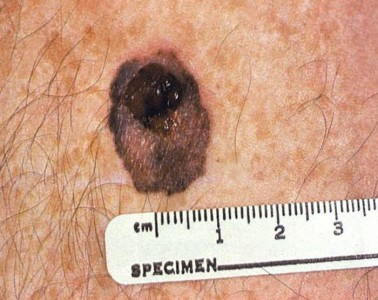 Melanoma[/caption]
Melanoma[/caption]
The radiation and tanning experts at the FDA disagree with the tanning industry on this one. Ditto that for the experts at the CDC. The skin’s reaction to the assault of UVA and UVB rays from indoor tanning or outdoor sun exposure is the production of melanin, the pigment within one’s skin that darkens it to a tan. Thus a tan is a sign of damage to the skin that a person’s body is working to protect against. The CDC notes that aside from melanoma, indoor tanning can also lead to basal cell carcinoma and squamous cell carcinoma, the other two forms of skin cancer, as well as ocular melanoma (cancer of the eye) and even cataracts. Not to mention premature aging like wrinkles and age spots.
photo credit: tanning bed via photopin (license)
photo credit: Side effects may include skin cancer. via photopin (license)
You May Also Like
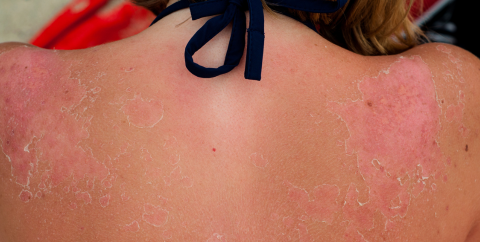
Skin cancer continues to be most common cancer in Nevada, U.S.
05.01.2023
More people are diagnosed with skin cancer each year in Nevada than all other cancers combined, according to the American Can
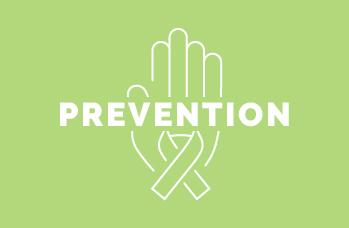
2023 Skin Cancer Awareness Month Tools
04.14.2023
Skin Cancer Awareness Month is recognized each May.
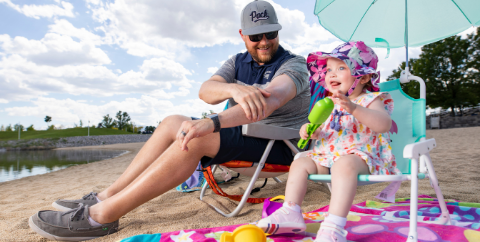
Get Ready: Skin Cancer Awareness Month is Nearly Here
04.27.2022
It’s nearly our favorite time of year: Skin Cancer Awareness Month.